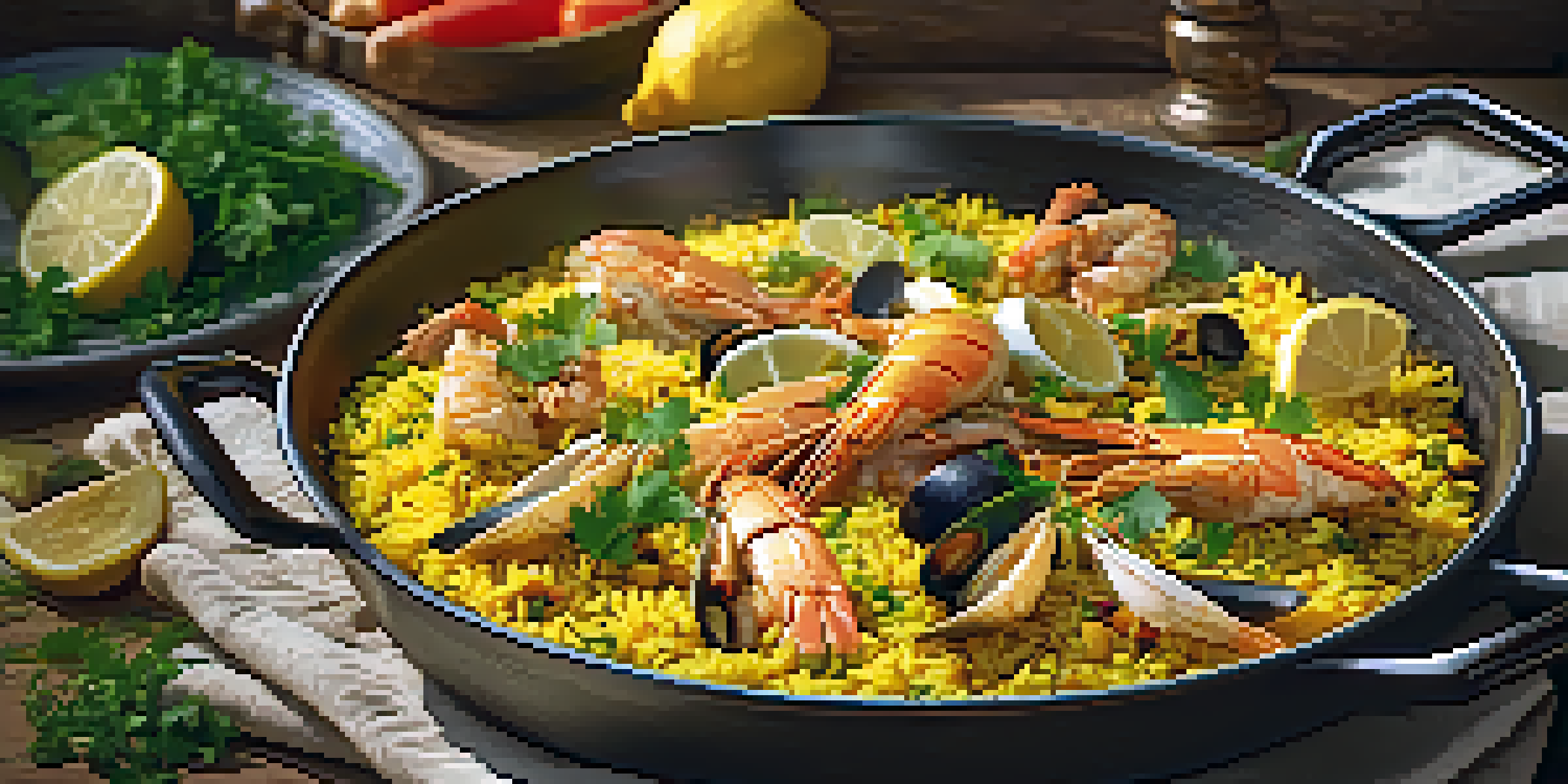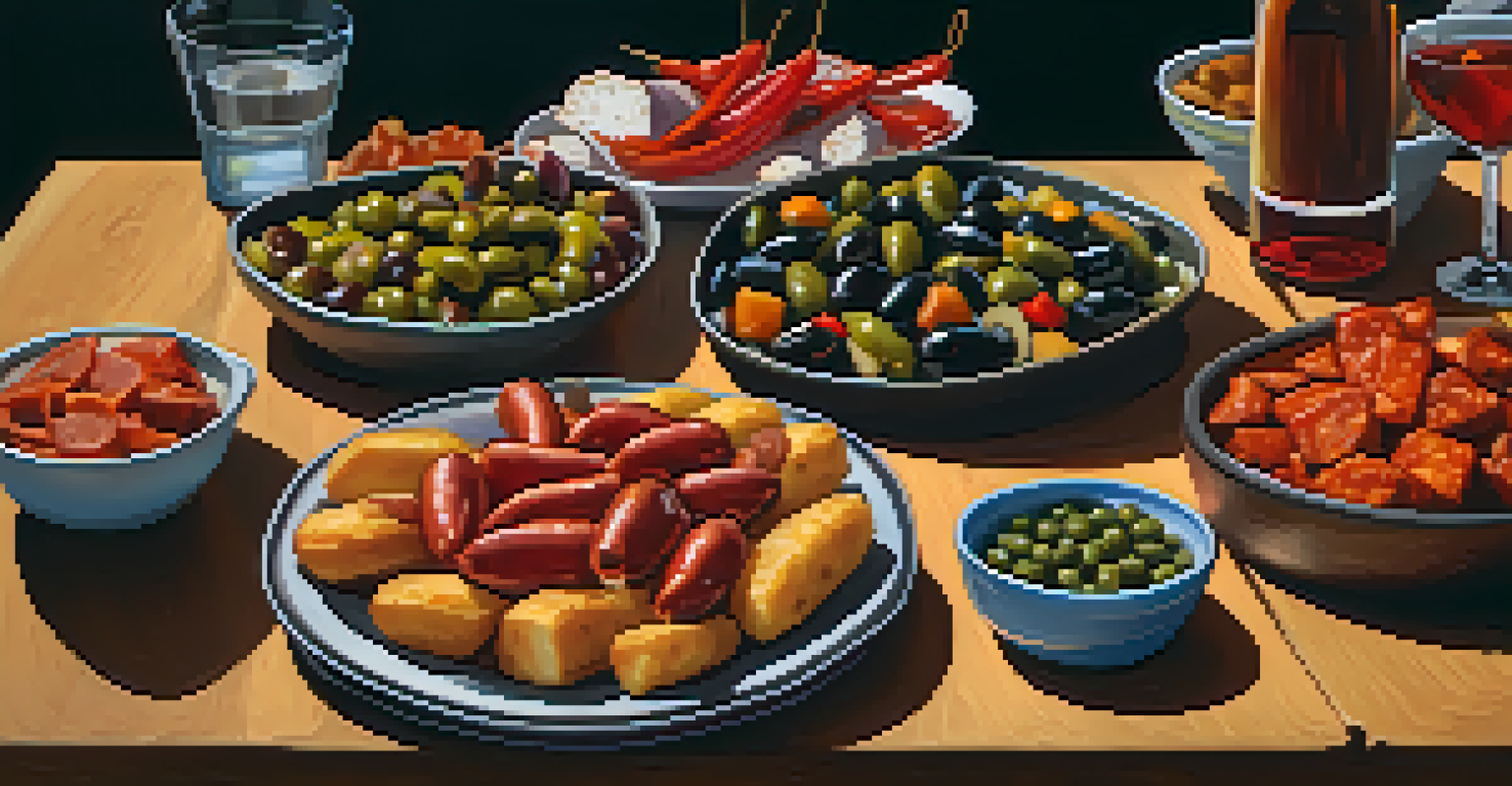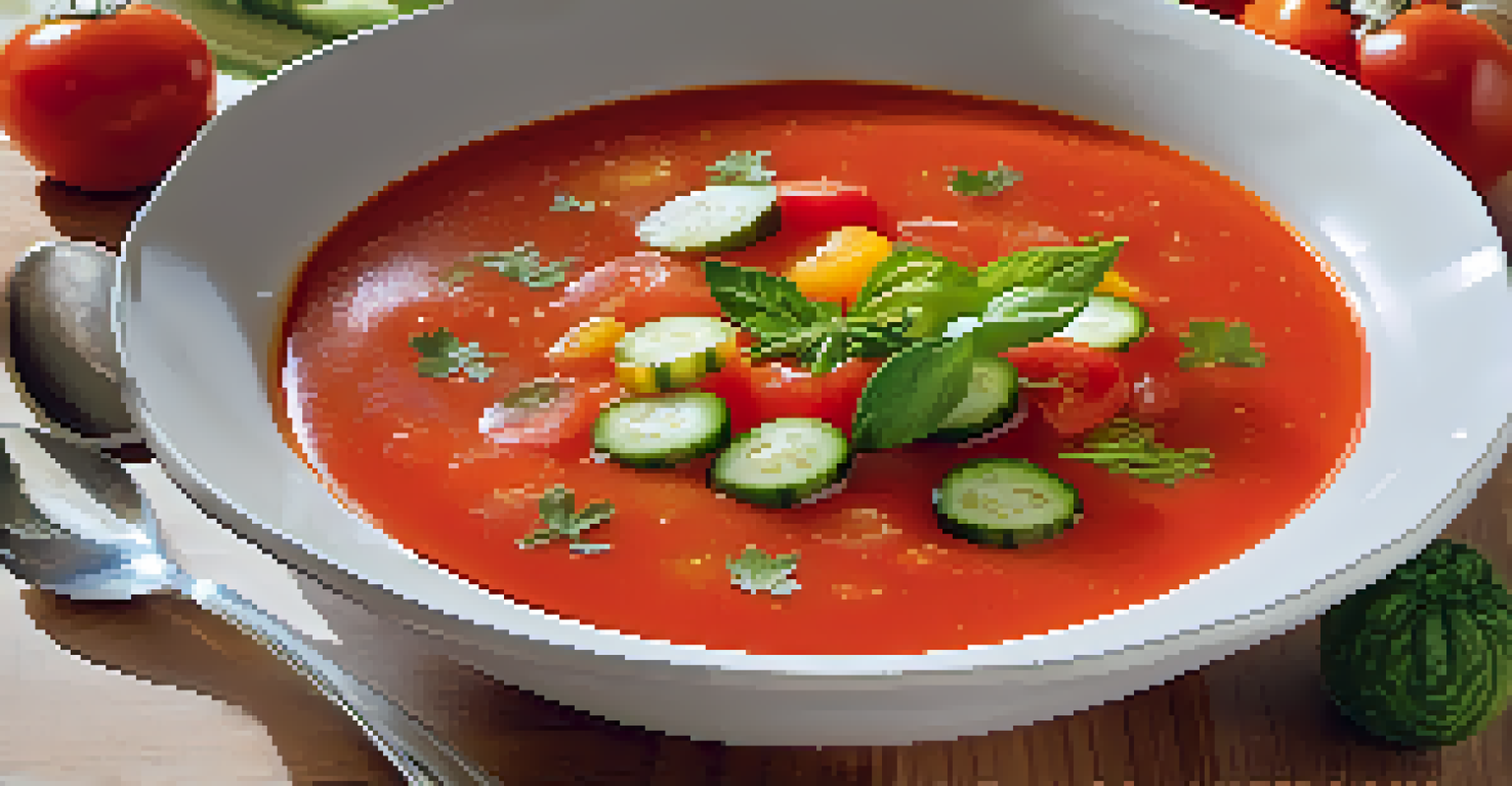Traditional Spanish Dishes That Have Withstood Time

Paella: A Flavorful Spanish Classic from Valencia
Paella is perhaps the most iconic Spanish dish, originating from Valencia. This vibrant rice dish is often a communal experience, bringing friends and family together around the table. Traditionally, it combines saffron-infused rice with various proteins, such as chicken, rabbit, and seafood, creating a symphony of flavors.
Food is our common ground, a universal experience.
The beauty of paella lies in its versatility; there are countless regional variations. For instance, the seafood paella from the coastal areas is a must-try for seafood lovers, while the vegetarian version caters to those seeking a meat-free option. No matter the variation, the love for this dish has ensured its place in Spanish culture for centuries.
Cooking paella is an art in itself, often done in a large, shallow pan over an open flame. The crispy socarrat, or the layer of toasted rice at the bottom, is a prized feature that every paella enthusiast seeks. By sharing this dish, you're not just serving a meal but also a piece of Spanish heritage.
Tapas: Small Plates with Big Flavor
Tapas represent a culinary tradition that embodies the social spirit of Spain. These small plates can be anything from olives and cheese to more elaborate dishes like patatas bravas or albondigas (meatballs). The idea is to share, encouraging conversation and connection over delicious bites.

Originating as a way to cover drinks (the word 'tapa' means 'lid'), tapas have evolved into a remarkable dining experience. Each region has its specialties, such as the spicy chorizo from Andalusia or the seafood options from Galicia. This variety makes tapas an exciting exploration of Spanish flavors.
Paella: A Communal Culinary Experience
This iconic dish from Valencia brings people together, showcasing its rich flavors and cultural significance.
Whether enjoyed at a bustling bar or a cozy home gathering, tapas are about more than just food; they celebrate community and culture. This dining style has stood the test of time, proving that good company and good food are a timeless combination.
Gazpacho: A Refreshing Cold Soup for Hot Days
Gazpacho is a cold soup that hails from the southern region of Andalusia, perfect for hot summer days. Made primarily from ripe tomatoes, peppers, cucumbers, and onions, this dish is not only refreshing but also packed with nutrients. The vibrant colors and flavors make it a feast for the eyes and the palate.
The best way to experience a culture is through its food.
What sets gazpacho apart is its simplicity; it's made by blending fresh ingredients, often served chilled with a drizzle of olive oil. Over the years, variations have emerged, including fruit-based versions like watermelon gazpacho, showcasing its adaptability. It's a dish that highlights the importance of fresh, seasonal produce in Spanish cuisine.
Traditionally enjoyed as a starter, gazpacho has become a staple in many households and restaurants alike. Its ability to cool down on a scorching day while delivering bursts of flavor makes it a timeless favorite in the Spanish culinary repertoire.
Tortilla Española: A Spanish Omelette with Heart
The Tortilla Española, or Spanish omelette, is a beloved dish that combines simplicity and heartiness. Made with just three main ingredients—eggs, potatoes, and onions—this dish showcases the beauty of comfort food. It's often served as a tapa or a main dish, enjoyed warm or at room temperature.
The cooking process involves frying the potatoes and onions before folding them into beaten eggs, creating a fluffy, thick omelette. Each family has its secret to making the perfect tortilla, with some opting for a runny center while others prefer a firmer texture. This personal touch adds to its charm and widespread popularity.
Tapas: Sharing Small Plates
Tapas encourage social interaction and exploration of diverse Spanish flavors through small, shareable dishes.
The tortilla is more than just a dish; it’s a symbol of Spanish home cooking. Its presence at gatherings, picnics, and celebrations speaks to its versatility and the way it brings people together, making it a staple in Spanish cuisine for generations.
Churros: Sweet Treats That Are Irresistible
Churros are a delightful Spanish pastry that has captured the hearts of many. These fried dough sticks, often dusted with sugar, are typically enjoyed for breakfast or as a snack. The combination of crispy exterior and soft, doughy interior makes them a favorite among both locals and visitors alike.
Traditionally, churros are served with a cup of thick hot chocolate for dipping, creating an indulgent treat. While churros can be found in various forms and flavors around the world, the Spanish version remains classic and beloved. Their popularity has transcended borders, making them a global dessert sensation.
In Spain, churros are often enjoyed at churrerías, specialized shops dedicated to this sweet treat. Sharing churros with loved ones over a warm cup of chocolate is an experience that speaks to the heart of Spanish culture, making this dessert a timeless favorite.
Pisto: A Ratatouille with a Spanish Twist
Pisto is Spain's answer to ratatouille, a vegetable medley that celebrates the bounty of summer produce. Typically made with tomatoes, peppers, zucchini, and eggplant, this dish is as colorful as it is flavorful. It's often served with a fried egg on top, adding richness to the fresh vegetables.
This dish hails from the La Mancha region, where it takes advantage of the local harvest. Each household may have its unique twist, whether it's the addition of chorizo or a drizzle of olive oil, showcasing the flexibility of the recipe. Pisto embodies the essence of Spanish cooking—simplicity and quality ingredients.
Flan: A Timeless Spanish Dessert
Flan's creamy texture and rich flavor make it a beloved dessert that creates cherished memories at gatherings.
Pisto can be enjoyed as a main dish, a side, or even as a topping for bread. Its comforting flavors and vibrant presentation make it a beloved dish that continues to hold a special place in Spanish cuisine, reminding us of the joys of home-cooked meals.
Flan: A Creamy Dessert That Is a Spanish Classic
Flan is a traditional Spanish dessert that has captivated sweet-toothed individuals for generations. This creamy caramel custard is known for its smooth texture and rich flavor, making it a perfect ending to any meal. Flan's simplicity in ingredients—eggs, milk, and sugar—belies its luxurious taste.
Often served chilled, flan has a glossy caramel glaze that adds a touch of elegance. Variations exist across Latin America and Spain, with flavors ranging from vanilla to coconut, but the classic version remains a favorite. Its versatility ensures that it can be made for any occasion, from casual family dinners to festive celebrations.

Sharing flan with friends and family is a delightful experience, as it brings a sweet note to gatherings. Its enduring popularity is a testament to how a simple dessert can create cherished memories, making flan a timeless staple in Spanish culinary traditions.